CorRelator: Interactive software for real-time high precision cryo-correlative light and electron microscopy
- PMID: 33610654
- PMCID: PMC8601405
- DOI: 10.1016/j.jsb.2021.107709
CorRelator: Interactive software for real-time high precision cryo-correlative light and electron microscopy
Abstract
Cryo-correlative light and electron microscopy (CLEM) is a technique that uses the spatiotemporal cues from fluorescence light microscopy (FLM) to investigate the high-resolution ultrastructure of biological samples by cryo-electron microscopy (cryo-EM). Cryo-CLEM provides advantages for identifying and distinguishing fluorescently labeled proteins, macromolecular complexes, and organelles from the cellular environment. Challenges remain on how correlation workflows and software tools are implemented on different microscope platforms to support automated cryo-EM data acquisition. Here, we present CorRelator: an open-source desktop application that bridges between cryo-FLM and real-time cryo-EM/ET automated data collection. CorRelator implements a pixel-coordinate-to-stage-position transformation for flexible, high accuracy on-the-fly and post-acquisition correlation. CorRelator can be integrated into cryo-CLEM workflows and easily adapted to standard fluorescence and transmission electron microscope (TEM) system configurations. CorRelator was benchmarked under live-cell and cryogenic conditions using several FLM and TEM instruments, demonstrating that CorRelator reliably supports real-time, automated correlative cryo-EM/ET acquisition, through a combination of software-aided and interactive alignment. CorRelator is a cross-platform software package featuring an intuitive Graphical User Interface (GUI) that guides the user through the correlation process. CorRelator source code is available at: https://github.com/wright-cemrc-projects/corr.
Keywords: Algorithm; Alignment; Correlative light and electron microscopy; Cryo-electron microscopy; Cryo-electron tomography; Cryo-fluorescence microscopy.
Copyright © 2021 The Authors. Published by Elsevier Inc. All rights reserved.
Conflict of interest statement
Declaration of Competing Interest
The authors declare that they have no known competing financial interests or personal relationships that could have appeared to influence the work reported in this paper.
Figures
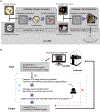
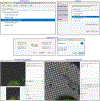
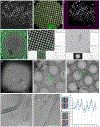
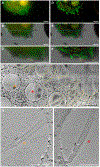


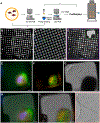
Similar articles
-
Recent advances in correlative cryo-light and electron microscopy.Curr Opin Struct Biol. 2024 Dec;89:102934. doi: 10.1016/j.sbi.2024.102934. Epub 2024 Oct 3. Curr Opin Struct Biol. 2024. PMID: 39366119 Review.
-
AutoCLEM: An Automated Workflow for Correlative Live-Cell Fluorescence Microscopy and Cryo-Electron Tomography.Sci Rep. 2019 Dec 16;9(1):19207. doi: 10.1038/s41598-019-55766-8. Sci Rep. 2019. PMID: 31844138 Free PMC article.
-
High-vacuum optical platform for cryo-CLEM (HOPE): A new solution for non-integrated multiscale correlative light and electron microscopy.J Struct Biol. 2018 Jan;201(1):63-75. doi: 10.1016/j.jsb.2017.11.002. Epub 2017 Nov 4. J Struct Biol. 2018. PMID: 29113848
-
Advanced cryo-tomography workflow developments - correlative microscopy, milling automation and cryo-lift-out.J Microsc. 2021 Feb;281(2):112-124. doi: 10.1111/jmi.12939. Epub 2020 Jul 2. J Microsc. 2021. PMID: 32557536
-
Advances in Cryo-Correlative Light and Electron Microscopy: Applications for Studying Molecular and Cellular Events.Protein J. 2019 Dec;38(6):609-615. doi: 10.1007/s10930-019-09856-1. Protein J. 2019. PMID: 31396855 Review.
Cited by
-
Assembly of respiratory syncytial virus matrix protein lattice and its coordination with fusion glycoprotein trimers.Nat Commun. 2024 Jul 14;15(1):5923. doi: 10.1038/s41467-024-50162-x. Nat Commun. 2024. PMID: 39004634 Free PMC article.
-
Recent advances and current trends in cryo-electron microscopy.Curr Opin Struct Biol. 2022 Dec;77:102484. doi: 10.1016/j.sbi.2022.102484. Epub 2022 Oct 28. Curr Opin Struct Biol. 2022. PMID: 36323134 Free PMC article. Review.
-
Better, Faster, Cheaper: Recent Advances in Cryo-Electron Microscopy.Annu Rev Biochem. 2022 Jun 21;91:1-32. doi: 10.1146/annurev-biochem-032620-110705. Epub 2022 Mar 23. Annu Rev Biochem. 2022. PMID: 35320683 Free PMC article. Review.
-
Recent advances in correlative cryo-light and electron microscopy.Curr Opin Struct Biol. 2024 Dec;89:102934. doi: 10.1016/j.sbi.2024.102934. Epub 2024 Oct 3. Curr Opin Struct Biol. 2024. PMID: 39366119 Review.
-
Integrated Fluorescence Microscopy (iFLM) for Cryo-FIB-milling and In-situ Cryo-ET.bioRxiv [Preprint]. 2023 Jul 12:2023.07.11.548578. doi: 10.1101/2023.07.11.548578. bioRxiv. 2023. PMID: 37502891 Free PMC article. Preprint.
References
-
- Agronskaia AV, Valentijn JA, van Driel LF, Schneijdenberg CTWM, Humbel BM, van Bergen en Henegouwen PMP, Verkleij AJ, Koster AJ, Gerritsen HC, 2008. Integrated fluorescence and transmission electron microscopy. Journal of Structural Biology 164 (2), 183–189. 10.1016/j.jsb:2008.07.003. - DOI - PubMed
Publication types
MeSH terms
Grants and funding
LinkOut - more resources
Full Text Sources
Other Literature Sources

